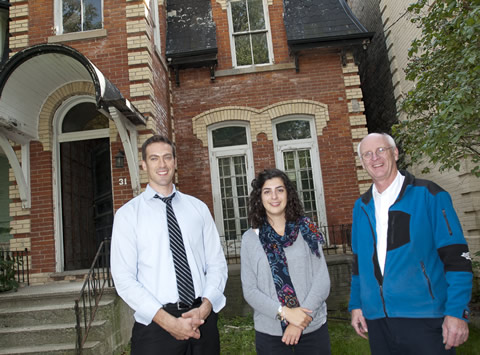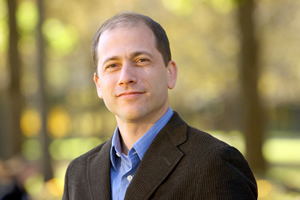With its red brick exterior, Edwardian entryway and small tower rising above the second storey, 31 Sussex Avenue looks run down, but still possessed of its 19th-century stateliness.
This university-owned house, though, has become part of a research project that makes its future much more interesting than its past. Kim Pressnail, a professor of civil engineering, and one of his former students, Russell Richman, a professor at Ryerson University, are stripping the house to its bones, and rebuilding it with “nested thermal zones” that should make it up to 80 per cent more energy-efficient.
“Normally within a single family dwelling, there is one zone – everything is heated to the same temperature,” Pressnail says. “Our concept is to create two thermal zones within that building – a core zone and a perimeter zone – and insulate them both. Occupants then have the option of heating only the core.” He adds that the perimeter zone can be heated in a matter of hours, meaning the occupants don’t have to say goodbye to their guest bedroom for the entire winter.
Building thermal zones into new homes is easier, but this project is meant to test how well houses can be retrofitted. “This house is probably the toughest assignment we could have. It was built in 1879,” says Pressnail. “It’s a listed historic property, so we can’t change the facade. There are also internal architectural features we don’t want to change.”
If thermal zones prove viable at 31 Sussex, it will demonstrate that the concept is viable for almost any home, he says. Pressnail and his research team plan to augment energy savings through the use of a heat pump. Unlike conventional heating methods, heat pumps don’t actually generate heat. Instead, they move existing heat from one place to another – extracting heat from one area and releasing it in another.
Refrigerators and air conditioners use heat pumps to remove energy from a contained space and expel it into the environment. But that process can be reversed: a heat pump can draw energy from cooler air and pump it into the core of the house to warm it.
Heat pumps run on electricity, but it takes less energy to move heat than to generate it. In fact, the closer the inside and outside temperatures are, the more efficient a heat pump becomes. In a conventional house, a heat pump would draw energy directly from the outside, meaning that on a cold day, it would not be much more efficient than other heating methods. But in a zoned house, the pump can draw heat efficiently from the perimeter zone, which is warmer than the outside.
In these circumstances, a heat pump can be up to three times as efficient as other methods. (And during hot summer months, heat pumps can work in the opposite direction, creating energy-efficient cooling.)
Pressnail’s team plans to complete the retrofit by June. For the following year, a designated occupant will live in and operate the house as efficiently as possible – providing a best-case scenario. Subsequently, the property will become a home for visiting faculty with less stringent operating instructions – allowing the researchers to assess how people actually make use of the options available to them.
At current electricity rates, Pressnail says, it would take about 15 years to recoup the additional costs of building thermal zones in a new house, and longer for a retrofit. But he believes energy costs will rise faster than inflation, meaning the savings become more significant over time. He also points out some side benefits. “The walls are warmer, the house is less drafty and it’s quieter,” he says. “A low-energy home is more comfortable.”
Recent Posts
U of T’s 197th Birthday Quiz
Test your knowledge of all things U of T in honour of the university’s 197th anniversary on March 15!
Are Cold Plunges Good for You?
Research suggests they are, in three ways
Work Has Changed. So Have the Qualities of Good Leadership
Rapid shifts in everything from technology to employee expectations are pressuring leaders to constantly adapt







7 Responses to “ A House Divided ”
15-year return on investment seems like you are approaching this the wrong way.
This might work for heating (I doubt it) but not for air conditioning so far as I can see. In Australian we use air conditioners that are reverse cycle - in Tasmania which is colder they are referred to as heat pumps. Most of these are closed systems that presume the existence of ventilation to outside.
The key to running costs with a/c is the extent to which cooled air is recycled. The percentage of outside air drawn in is crucial to comfor , otherwise the air becomes stale and people develop headaches. Drawing input air in from peripheral rooms is recycling too, so I cannot see that in the case of cooling it really makes any difference except in that you are recycling using warmer air than that recycled from the cooled area.
As for the situation during the heating cycle, it is debateable. Drawing air in from the non cooled area means that that air will be replaced by air drawn in from both outside the house and from within. Ultimately the percentage of cold exterior air that needs to be drawn in will be the same.
I think the researchers here have made the mistake of considering coolling and heating systems as "closed systems" - which they are not.
That's fascinating! How can one find out where to get builders to do this?
It's worth noting that this is a research project. Prof. Pressnail responds:
@Tally: A 15 year payback is the MAXIMUM, conservative estimate based on static energy prices. If energy prices continue to rise at 2% more than inflation, then the payback period is in the single digits! Further, even accepting a 15-year payback, you will be reducing your energy consumption by 75% of the energy and the corresponding greenhouses gases. Aren’t your grandchildren worth it?
@Phil: This approach of nested thermal envelopes works in both cold and hot climates. Fresh air is provided to the various zones as needed using a dedicated outdoor air system that is passed through an energy recovery ventilator (80% efficient). The advantage of an interzonal heat pump is that it functions more efficiently than an outdoor air source heat pump in the winter. In the summer, it can be reversed and if desired, some of the expelled heat can be stored in the thermal mass in the basement for use later, when supplemental heating is required.
@Mary: People are already building zones within commercial buildings. We’re just doing it in a single family home. This is just one of many strategies that can be used to reduce energy costs. And as energy costs escalate, builders may well begin to build this way!
Can I arrange to visit this research project? I am a consulting engineer and I have inspected over 8,000 homes in the GTA as a full time home inspector since 1994.
For more information or to arrange a tour, contact Professor Pressnail, Department of Civil Engineering, University of Toronto, at (416) 978-1501 or pressna [at] civ.utoronto.ca. View photos at http://uoft.me/gemini
I was born at 31 Sussex in 1951. I am so pleased that it is being fixed up. I remember the beautiful staircase and the fireplace. My parents sold the house in 1958. My late father was the Canadian composer Godfrey Ridout and a member of the music faculty at U of T.